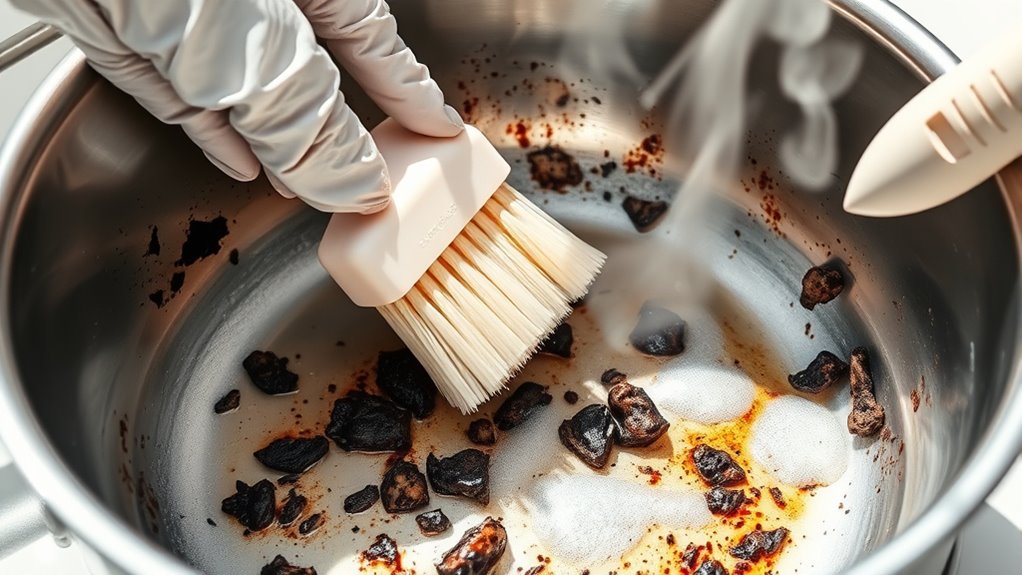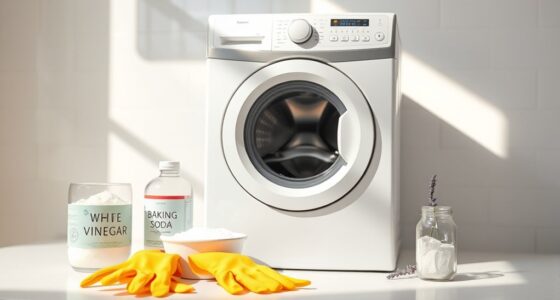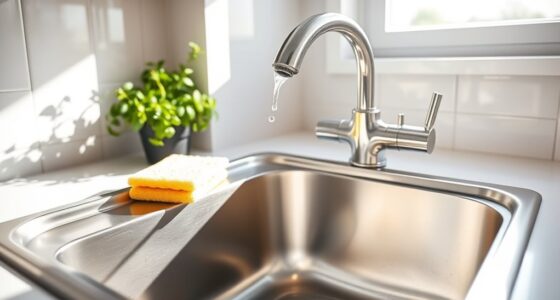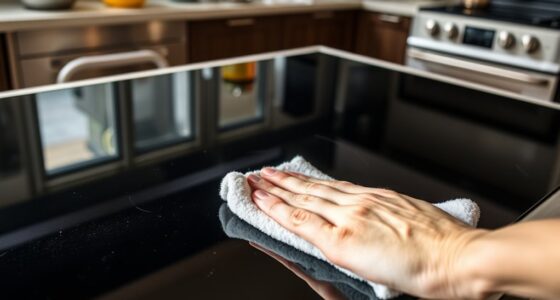To clean burnt food from stainless steel pots, fill the pot with water covering the burnt area, add dish soap and vinegar or lemon juice, then bring it to a boil and simmer for 10-15 minutes. After cooling slightly, pour out the water, and gently scrub with a soft sponge or non-abrasive scrubber. For stubborn stains, sprinkle baking soda and let it sit before scrubbing again. For more tips, keep exploring these effective cleaning techniques.
Key Takeaways
- Fill the pot with water, dish soap, and vinegar or lemon juice, then simmer to loosen burnt residues.
- Remove hot water and scrub gently with a soft sponge; apply baking soda paste for tougher spots.
- For stubborn stains, soak the pot in warm water with stainless steel cleaner or baking soda-vinegar mixture overnight.
- Regularly rinse and dry to prevent water spots and use gentle cleaning tools to avoid scratching surfaces.
- Incorporate natural acids like vinegar for maintenance and promptly address stains to keep your pot in good condition.
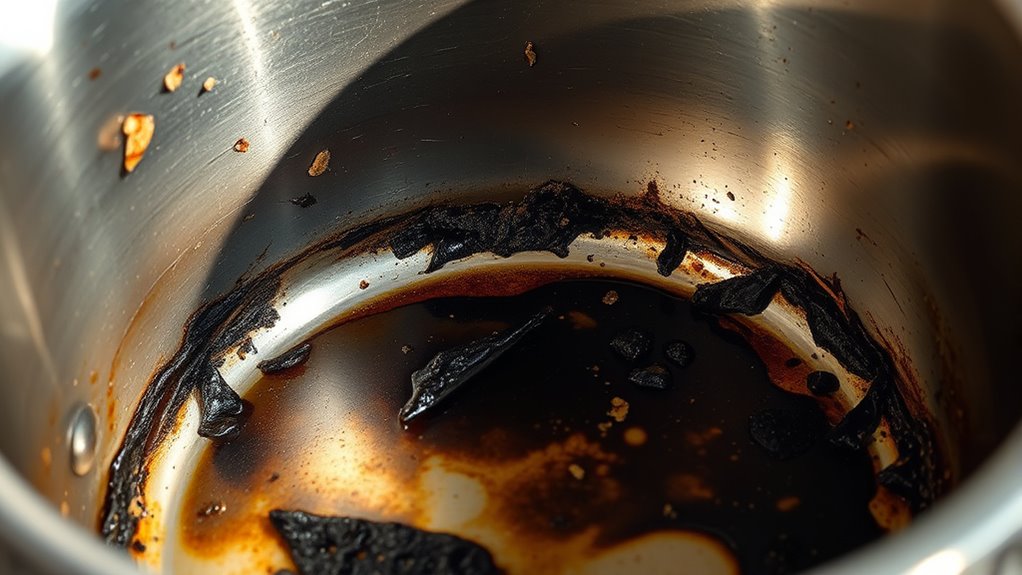
Stainless steel pots are durable and versatile, but they can develop stains, water spots, and discoloration over time. When it comes to cleaning burnt food off your cookware, understanding effective cleaning techniques is essential to keep your pots looking and functioning their best. Burnt food can be stubborn, but with the right approach, you can restore your stainless steel cookware without damaging the surface.
Start by filling your pot with enough water to cover the burnt area. Add a few drops of dish soap and a generous amount of white vinegar or lemon juice. These natural acids help loosen burnt residues and break down grease. Bring the mixture to a boil over medium heat, then let it simmer for about 10-15 minutes. This process softens the burnt food, making it easier to scrub away later. Make sure to turn off the heat and allow the mixture to cool slightly before handling.
Fill your pot with water, dish soap, and vinegar; boil to loosen burnt food for easier cleaning.
Once cooled, pour out the hot water and residue. Use a non-abrasive scrubber or a soft sponge to gently scrub the remaining burnt spots. For tougher spots, sprinkle baking soda over the affected areas and add a few drops of water to create a paste. Let this sit for 10-15 minutes. Baking soda’s gentle abrasive properties help lift stubborn stains without scratching the stainless steel surface. Afterward, scrub again using the sponge or soft brush, focusing on areas with burnt residue.
If stains persist, fill the pot with warm water and add a commercial stainless steel cleaner or a mixture of baking soda and vinegar. Let it soak for a couple of hours or overnight if necessary. This deep cleaning technique can help remove discoloration or water spots that develop over time. Regular maintenance is also important—using appropriate cleaning tools and avoiding harsh abrasives can extend the lifespan of your cookware. Always rinse thoroughly to remove any cleaning residues, and dry your cookware with a soft cloth to prevent water spots.
With consistent cleaning techniques and proper maintenance, your stainless steel cookware can stay in excellent condition, making cooking and cleaning a breeze.
Frequently Asked Questions
Can I Use Steel Wool to Clean Stainless Steel Pots?
You can use steel wool to clean stainless steel pots, but do so carefully. Steel wool is effective for stubborn spots but can scratch the surface if you press too hard. Alternatively, use gentle scrubbing pads for regular cleaning and reserve steel wool for tough, burnt-on food. Always test a small area first, and avoid aggressive scrubbing to keep your pots looking new and shiny.
Is It Safe to Use Bleach on Stainless Steel Cookware?
Did you know that over 40% of people accidentally damage their cookware with harsh chemicals? Using bleach on stainless steel isn’t safe, as chemical cleaners can cause discoloration and corrosion. Instead, rely on physical scrubbing with gentle abrasives or baking soda. This keeps your pots shiny without risking damage, ensuring they stay in great shape for years to come. Always choose safe cleaning methods to preserve your cookware’s quality.
How Do I Prevent Burnt Food From Sticking in the Future?
To prevent burnt food from sticking in the future, start by using proper seasoning techniques on your stainless steel pots, like heating them gently and adding oil before cooking. Avoid using non-stick coatings on stainless steel, but make certain your cookware is well-seasoned to create a natural non-stick surface. Keep heat at moderate levels, stir frequently, and don’t overcrowd the pot, helping food cook evenly without sticking or burning.
Can Dishwasher Detergent Damage Stainless Steel Pots?
Think of dishwasher detergent as a powerful but gentle gardener’s tool. While dishwasher safety guarantees it won’t harm your stainless steel pots, using it improperly might cause tiny scratches or dull the shine, risking stainless steel durability over time. If you follow manufacturer instructions and avoid harsh abrasives, you’ll keep your pots looking shiny and new, enjoying their resilience without worry.
What Natural Remedies Work Best for Stubborn Burnt Residue?
For stubborn burnt residue, eco-friendly solutions like baking soda remedies work wonders. Sprinkle baking soda generously over the affected area, then add a bit of water to form a paste. Let it sit for 15-30 minutes, allowing the natural abrasiveness to loosen the grime. Scrub gently with a soft sponge or brush, and rinse thoroughly. This method is safe, effective, and environmentally friendly, leaving your stainless steel pots sparkling clean.
Conclusion
Now that you know how to tackle burnt food in your stainless steel pots, you’re equipped to restore their shine and shine like new. With patience and the right techniques, stubborn stains will fade away, revealing a surface as bright as your kitchen’s spirit. Think of your pots as a mirror to your perseverance—each cleaning session bringing you closer to culinary perfection. Keep at it, and your pots will thank you with years of sparkling service.

